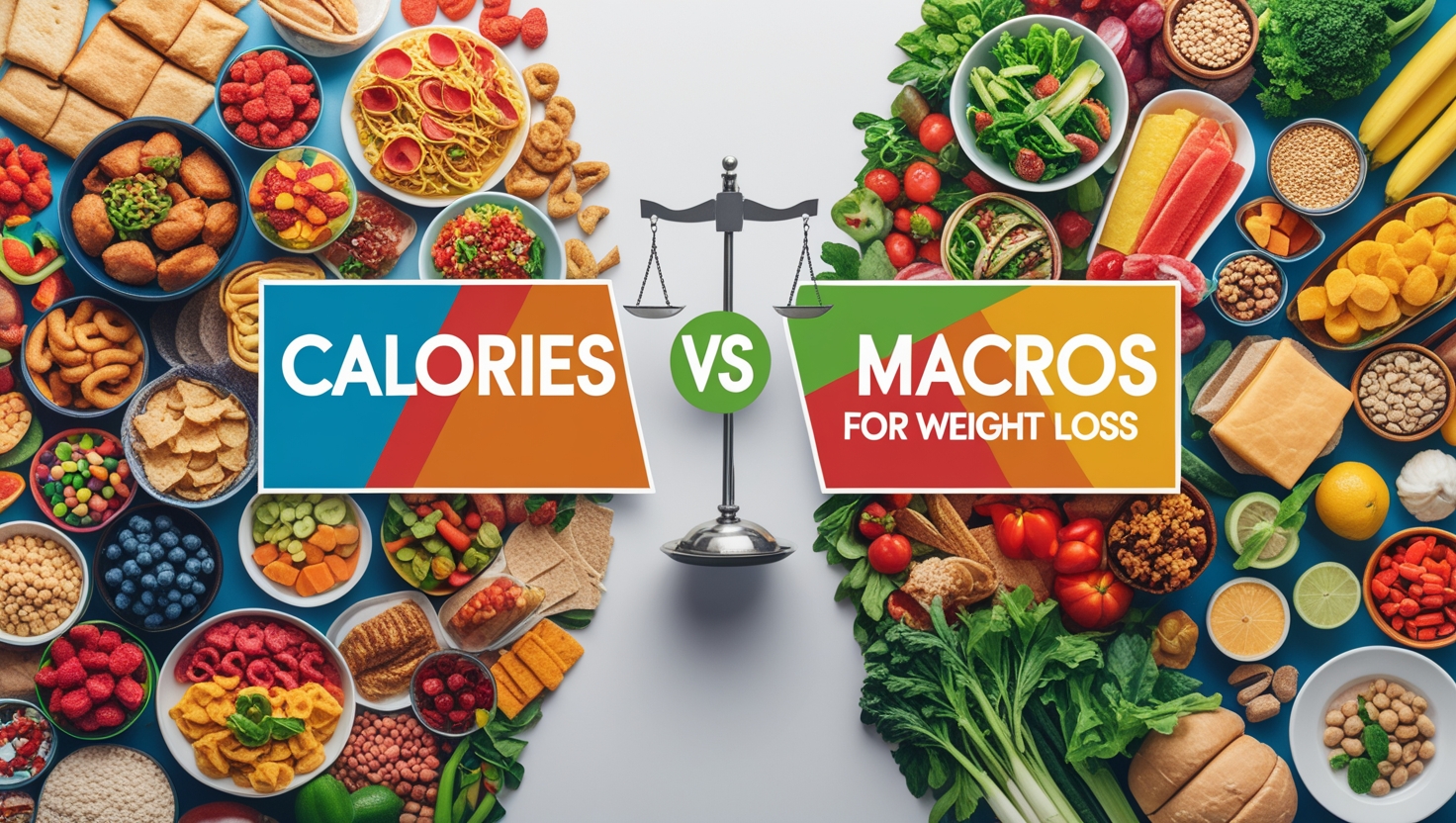Which Matters More for Weight Loss: Calories or Macros?
Have you thought about whether calories or macros are more important for losing weight? This question has sparked a big debate. Many people are now thinking differently about what they eat every day.
Both calories and macros are very important for losing weight. Knowing how to use them can really help you reach your goals. Let’s look into this to see which one is more important in your diet.

Key Takeaways
- Calories and macros both significantly impact weight loss.
- Understanding your daily caloric needs is vital for effective weight management.
- Macros play an essential role in how your body processes food and energy.
- Finding the right balance between calories and macros can enhance your nutrition strategy.
- Personalizing your approach to include the right nutrients is key to long-term success.
Understanding the Basics of Weight Loss
Weight loss is about balancing energy. You lose weight when you eat less than your body uses. This is called a calorie deficit.
It’s not just about how many calories you eat. What you eat matters too. Eating healthy foods helps you stay full and keeps you healthy.
Many things affect your diet and weight loss. Exercise, managing stress, and sleeping well are important. These habits help you stay healthy and keep losing weight.
What Are Calories?
Calories are units of energy in food. They help your body work and move. When you eat, your body turns calories into energy for daily tasks.
Knowing how many calories you eat is key to managing your weight. Eating more calories than you burn leads to fat gain. This can make you heavier.
There are different kinds of calories. “Empty” calories are in foods like sugary snacks. They give energy but no good stuff for your body.
“Nutrient-dense” calories are in foods like fruits and veggies. They give you vitamins and minerals for health. Choosing these foods helps you eat right and manage your weight.
How much energy you use changes with what you do. Exercise helps burn calories and boosts your metabolism. Eating right and staying active keeps you healthy and fit.
The Role of Macros in Your Diet
Knowing about macros is key to good nutrition. Carbs, proteins, and fats are the main macros. They help your body in different ways. This info helps you eat better for health and losing weight.
Carbs give your body energy. You find them in fruits, whole grains, and veggies. Pick complex carbs for lasting energy. Simple carbs, like in sweets, give quick energy but then drop.
Proteins help fix and grow muscles. Good sources are lean meats, dairy, beans, and nuts. Eating enough protein keeps your muscles strong, even when you eat less.
Fats are important for health. Healthy fats from avocados, olive oil, and fish help your hormones and brain. Eating the right fats makes you feel full longer.
Mixing these macros right makes a diet that helps you lose weight and stay healthy. Here’s a table showing what each macro does and where to find it:
| Macronutrient | Primary Functions | Common Sources |
|---|---|---|
| Carbohydrates | Provide energy | Fruits, whole grains, vegetables |
| Proteins | Support muscle repair and growth | Lean meats, dairy, beans, nuts |
| Fats | Support hormone production and brain function | Avocados, olive oil, fish |
Calories vs. Macros – What’s More Important for Weight Loss?
Understanding calories and macros is key to losing weight. Each has its own role in your diet. Knowing how they work together helps you live healthier.
Defining Calories and Macros
Calories are the energy your body needs every day. They come from what you eat and drink. This energy helps your body work and move.
Macros, or macronutrients, are proteins, fats, and carbs. They add to your calorie count. Each macro does different things for your health and body shape.
How Both Factors Affect Weight Management
Calories and macros both play a part in weight loss. Eating fewer calories than you burn is key to losing weight. But, the mix of macros you eat matters too.
Eating more protein can make you feel full. This helps you eat less without feeling hungry. But, too many carbs or fats can make you gain weight, even if you eat fewer calories.
The Science Behind Weight Loss
Learning about weight loss means understanding how your body uses calories. It also means knowing how macronutrients play a big role. When you eat, your body starts to break down the calories into energy.
This energy-making process changes based on what you eat. This affects how well you manage your weight.
How Your Body Uses Calories
Calories are like money for your body. They give you energy. When you eat, your body breaks down these calories.
This breakdown includes your basic needs, like breathing. It also includes how active you are and how your body makes heat.
- Basal Metabolic Rate: This is how many calories your body needs to stay alive at rest.
- Physical Activity: Moving around burns more calories. Being active can make your metabolism faster.
- Thermogenesis: This is how your body makes heat. It uses calories to keep warm during digestion and exercise.
The Importance of Macronutrients
Macronutrients are carbs, proteins, and fats. Each one does something different in your diet. For example, protein takes more energy to digest than carbs or fats.
| Macronutrient | Caloric Content (per gram) | Role in Weight Loss |
|---|---|---|
| Carbohydrates | 4 | Primary energy source; aids in fueling workouts. |
| Proteins | 4 | Essential for muscle repair; promotes satiety. |
| Fats | 9 | Important for hormonal balance; enhances flavor and satisfaction. |
Understanding how your body uses calories and the role of macronutrients is key. It helps you know how to reach your health and fitness goals better.
Tracking Your Intake: Calories vs. Macros
Tracking what you eat is key for losing weight. It helps you understand your eating habits. You can use old-fashioned food diaries or new apps for this.
Apps like MyFitnessPal and Cronometer make tracking easy. They let you log your food fast and accurately. This way, you can see if you’re meeting your nutrition goals.
Keeping a food diary helps you know your portion sizes. It makes you think about what you eat. This method works well with apps, showing your progress.
It’s important to know about calories and macros. Calories tell you about energy, while macros show diet quality. Tracking them helps you meet your weight loss goals.
Using both apps and diaries can really help. It makes you more aware of your food choices. This leads to better eating habits and weight loss.
| Tracking Method | Advantages | Considerations |
|---|---|---|
| Mobile Apps | Convenient, real-time updates, extensive food database | Requires smartphone access, possible errors in food entries |
| Food Diary | Promotes mindfulness, easy to customize | Time-consuming, might not cover everything |
| Meal Plans | Predefined structure, saves time | May lack flexibility, needs planning |

Navigating Your Caloric Needs
Knowing how many calories you need is key for managing your weight. You can figure out your Basal Metabolic Rate (BMR) and total daily energy expenditure (TDEE). This helps you set the right number of calories to eat each day.
These steps help you lose weight or keep it stable. It’s all about finding the right balance.
Determining Your Basal Metabolic Rate
Your Basal Metabolic Rate is how many calories your body uses when you’re resting. It’s for basic things like breathing and keeping your cells alive. Your age, gender, weight, and height affect your BMR.
One way to find your BMR is with the Harris-Benedict equation. It gives you a personal estimate. Knowing your BMR helps you understand your calorie needs better.
Calculating Your Daily Caloric Intake
Once you know your BMR, you need to figure out your daily calorie needs. You do this by multiplying your BMR by an activity factor. This factor depends on how active you are.
For example, if you’re very active, you’ll need more calories. This gives you your total daily energy expenditure (TDEE). If you want to lose weight, eat fewer calories than your TDEE.
The Importance of Macronutrient Ratios
Knowing about macronutrient ratios is key for losing weight. Your body needs carbs, proteins, and fats to work right. Changing these ratios can help a lot with your health and weight.
Eating a lot of protein can help you lose weight. It makes you feel full and keeps your muscles strong. Eating less carbs can make your body use fat for energy. It’s all about finding the right mix for you.
Studies show different diets work in different ways. Knowing how macronutrients fit into your diet helps you eat better. Try different ratios to see what’s best for you.
Research backs up the idea of custom diets for better weight loss. Keep an eye on how you’re doing and change your diet if needed. This way, you can reach your fitness goals.
Healthy Eating: Balancing Calories and Macros
To lose weight, focus on calories and macros. Choose foods that are full of nutrients but not too many calories. A good meal plan lets you eat a variety of foods and make lasting changes.
Choosing the Right Foods for Weight Loss
For weight loss, pick foods that are full of nutrients. Add fruits, veggies, whole grains, lean proteins, and healthy fats to your meals. These foods give you the macros you need and don’t add too many calories. Here are some good food choices:
- Fruits: Berries, apples, and oranges are low in calories and high in fiber.
- Vegetables: Leafy greens, bell peppers, and broccoli are rich in vitamins and minerals.
- Proteins: Chicken, fish, legumes, and tofu offer essential building blocks for muscle recovery.
- Whole Grains: Quinoa, brown rice, and oats provide sustained energy without excessive calories.
- Healthy Fats: Avocados, nuts, and olive oil support brain health while keeping you satiated.
Building a Balanced Meal Plan
Creating a balanced meal plan means matching your calorie needs with your macro intake. First, figure out how many calories you need each day. Then, plan meals that include all food groups.
Here’s how to build your meal plan:
- Find out how many calories you need to lose weight.
- Plan meals with protein, fiber, and healthy fats.
- Watch your portion sizes to stay under your calorie limit.
- Try new flavors and cuisines to keep meals fun.
- Change your plan if it’s not working for your weight loss goals.

Fitness Goals: How to Align Calories and Macros
To reach your fitness goals, you need to balance calories and macros. Each goal, like gaining muscle or losing fat, needs a special plan. This plan includes how many calories and what types of macros to eat.
For losing fat, you must eat fewer calories than you burn. Eating more protein helps keep your muscles while you lose weight. Also, add healthy fats and carbs in small amounts to have energy for workouts.
To gain muscle, you need to eat more calories. This extra food fuels your workouts and helps your muscles recover. Eat lots of protein and some carbs to build muscle. Healthy fats help with hormones too.
For endurance training, carbs are key. They give you energy for long activities. But, don’t forget protein and healthy fats for recovery and health. Aim for a balanced mix to meet your training needs.
Aligning calories and macros with your fitness goals is key. By tailoring your diet to your goals, you set yourself up for success. This way, you can make steady progress and achieve your fitness dreams.
Personalizing Your Approach to Weight Loss
Understanding your own needs is key to losing weight. Things like age, gender, and how active you are matter. A good plan balances these things for lasting results.
Creating a diet plan that’s just for you means adjusting calories and what you eat. For example, if you’re very active, you might need more carbs for energy. But if you’re not as active, eating more protein can help keep your muscles strong.
- Find out how many calories you need each day to know how much to eat.
- Try different types of food, like more carbs or fats, to see what works for you.
- Keep an eye on how you’re doing and change your plan as needed to reach your goals.
It’s not just about eating less. It’s about knowing what your body needs and giving it the right food. This way, you’ll get better results and healthier habits for a long time.
Conclusion
Understanding weight loss means knowing about calories and macros. Both are key in your diet. Focusing too much on one can cause problems.
It’s important to see how calories and macros work together. The right mix of macronutrients, along with eating fewer calories, helps. This way, you can make better food choices.
For lasting weight loss, find a plan that fits you. Learn about your diet needs and try different foods. A healthy lifestyle is the goal. With the right information, you can get there.
FAQ
What is the difference between calories and macronutrients?
Calories measure how much energy food gives you. Macros are carbs, proteins, and fats. Both help with weight and knowing what you eat.
How does calorie deficit help with weight loss?
Eating fewer calories than you burn leads to weight loss. Your body uses fat for energy.
Are all calories the same when it comes to nutrition?
No, not all calories are the same. “Empty” calories from junk food don’t give you nutrients. But “nutrient-dense” calories from whole foods do.
What role do macronutrients play in my diet?
Macros are key for your body. Carbs give energy, proteins help muscles, and fats help hormones. Getting the right mix is important for fitness and weight.
How can I track my calorie and macronutrient intake effectively?
Use apps like MyFitnessPal or Cronometer to track what you eat. Keeping a food diary or using digital tools helps you stay on track.
What is the importance of macronutrient ratios in a diet?
The right mix of carbs, proteins, and fats is key for losing weight and staying healthy. It depends on your goals and how active you are.
How can I personalize my approach to weight loss?
Think about your age, gender, how active you are, and your health. Adjusting your diet to fit your needs can help you lose weight better.
Is it better to focus on calories or macros for weight loss?
Both are important for losing weight. Watching your calorie intake is key. But knowing your macro mix helps your body work best.







